Non-Hodgkin lymphomas (NHLs) are a diverse group of hematologic malignancies that are clonal proliferative disorders of mature or progenitor B cells, T cells, or natural killer (NK) cells. Most pediatric cases are aggressive and high-grade (but curable); in adults, low-grade subtypes are more common. Like Hodgkin lymphoma, which has distinct pathologic features and treatments, NHL often presents with constitutional signs of fever, night sweats, and weight loss. Clinical features include lymphadenopathy and hepatosplenomegaly, but some individuals present with extranodal involvement and abnormal lab findings. B-cell NHLs include diffuse large B-cell lymphoma, follicular lymphoma, Burkitt lymphoma, mantle cell lymphoma, and marginal zone lymphoma. T-cell NHLs include adult T-cell lymphoma and mycosis fungoides. Diagnosis is made by lymph node biopsy, bone marrow biopsy, or both. Management is with chemotherapy or targeted drugs. Radiation therapy is used in adults but not in children, and stem cell transplantation is used for patients with aggressive disease.
Last updated: May 17, 2024
Non-Hodgkin lymphomas (NHLs) are a diverse group of hematologic malignancies that are clonal proliferative disorders of mature or progenitor B cells B cells Lymphoid cells concerned with humoral immunity. They are short-lived cells resembling bursa-derived lymphocytes of birds in their production of immunoglobulin upon appropriate stimulation. B cells: Types and Functions, T cells T cells Lymphocytes responsible for cell-mediated immunity. Two types have been identified – cytotoxic (t-lymphocytes, cytotoxic) and helper T-lymphocytes (t-lymphocytes, helper-inducer). They are formed when lymphocytes circulate through the thymus gland and differentiate to thymocytes. When exposed to an antigen, they divide rapidly and produce large numbers of new T cells sensitized to that antigen. T cells: Types and Functions, or natural killer (NK) cells.
The pathogenesis of NHL involves multiple genetic lesions that affect proto-oncogenes Proto-Oncogenes Normal cellular genes homologous to viral oncogenes. The products of proto-oncogenes are important regulators of biological processes and appear to be involved in the events that serve to maintain the ordered procession through the cell cycle. Proto-oncogenes have names of the form c-onc. Cancer Immunotherapy and tumor Tumor Inflammation suppressor genes Genes A category of nucleic acid sequences that function as units of heredity and which code for the basic instructions for the development, reproduction, and maintenance of organisms. DNA Types and Structure. Abnormal cells also appear to escape immune surveillance Surveillance Developmental Milestones and Normal Growth.
Most lymphomas present with painless lymphadenopathy Lymphadenopathy Lymphadenopathy is lymph node enlargement (> 1 cm) and is benign and self-limited in most patients. Etiologies include malignancy, infection, and autoimmune disorders, as well as iatrogenic causes such as the use of certain medications. Generalized lymphadenopathy often indicates underlying systemic disease. Lymphadenopathy with variable Variable Variables represent information about something that can change. The design of the measurement scales, or of the methods for obtaining information, will determine the data gathered and the characteristics of that data. As a result, a variable can be qualitative or quantitative, and may be further classified into subgroups. Types of Variables peripheral blood, bone marrow Bone marrow The soft tissue filling the cavities of bones. Bone marrow exists in two types, yellow and red. Yellow marrow is found in the large cavities of large bones and consists mostly of fat cells and a few primitive blood cells. Red marrow is a hematopoietic tissue and is the site of production of erythrocytes and granular leukocytes. Bone marrow is made up of a framework of connective tissue containing branching fibers with the frame being filled with marrow cells. Bone Marrow: Composition and Hematopoiesis, GI, skin Skin The skin, also referred to as the integumentary system, is the largest organ of the body. The skin is primarily composed of the epidermis (outer layer) and dermis (deep layer). The epidermis is primarily composed of keratinocytes that undergo rapid turnover, while the dermis contains dense layers of connective tissue. Skin: Structure and Functions, or CNS involvement.
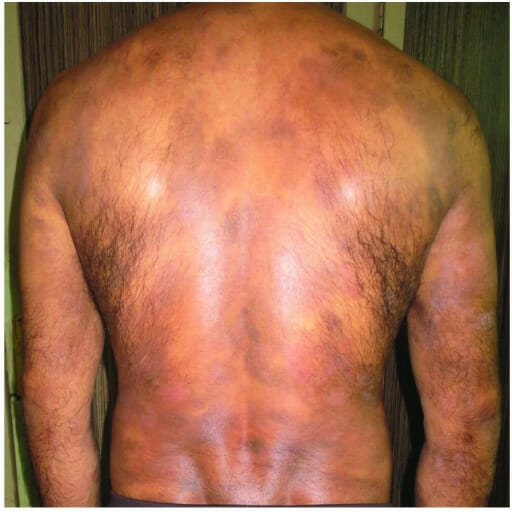
Mycosis fungoides in a 40-year-old man with a generalized rash
Image: “Mycosis fungoides in a 40-year-old man manifested as generalized atrophic patches” by F1000Research. License: CC BY 4.0Adequate diagnosis requires histologic examination, immunophenotyping, genotyping Genotyping Methods used to determine individuals’ specific alleles or snps (single nucleotide polymorphisms). Polymerase Chain Reaction (PCR), and consideration of the clinical features. Staging Staging Methods which attempt to express in replicable terms the extent of the neoplasm in the patient. Grading, Staging, and Metastasis is similar to that for Hodgkin lymphoma Lymphoma A general term for various neoplastic diseases of the lymphoid tissue. Imaging of the Mediastinum.
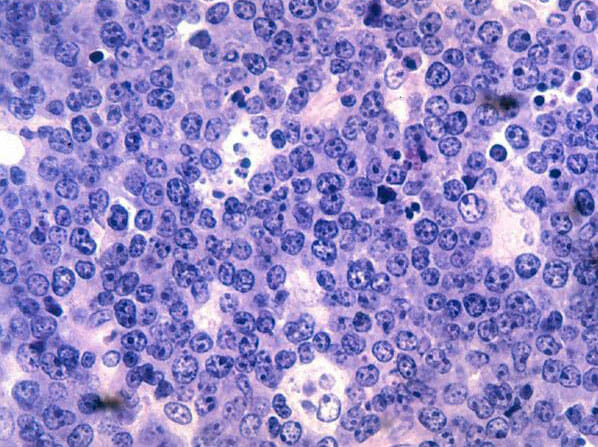
Histopathology of Burkitt lymphoma:
Malignant B-cell lymphocytes are seen. Note the classic “starry sky” appearance imparted by many enlarged, pale macrophages which have phagocytosed dead apoptotic tumor cells (small blue/purple-stained fragments) in this very rapidly dividing tumor. H&E stain.
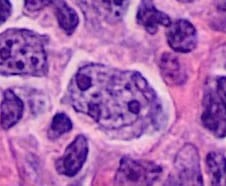
Histopathology of a centroblast (larger cell containing vesicular nuclei with 1–3 basophilic nuclei next to the nuclear membrane) in follicular lymphoma
Image: “Histopathology of a centroblast in follicular lymphoma” by Mikael Häggström, M.D. License: Public Domain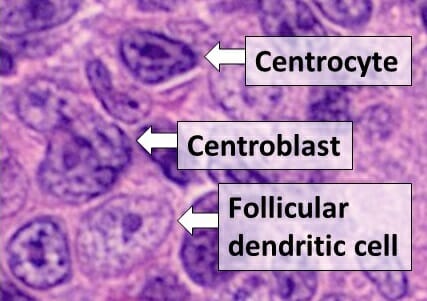
Histology of cell types in a germinal center, seen in follicular lymphoma, with centrocytes, centroblasts, and a follicular dendritic cell
Image: “Centrocyte, centroblast and follicular dendritic cell in a follicular_lymphoma” by Mikael Häggström, M.D. License: Public Domain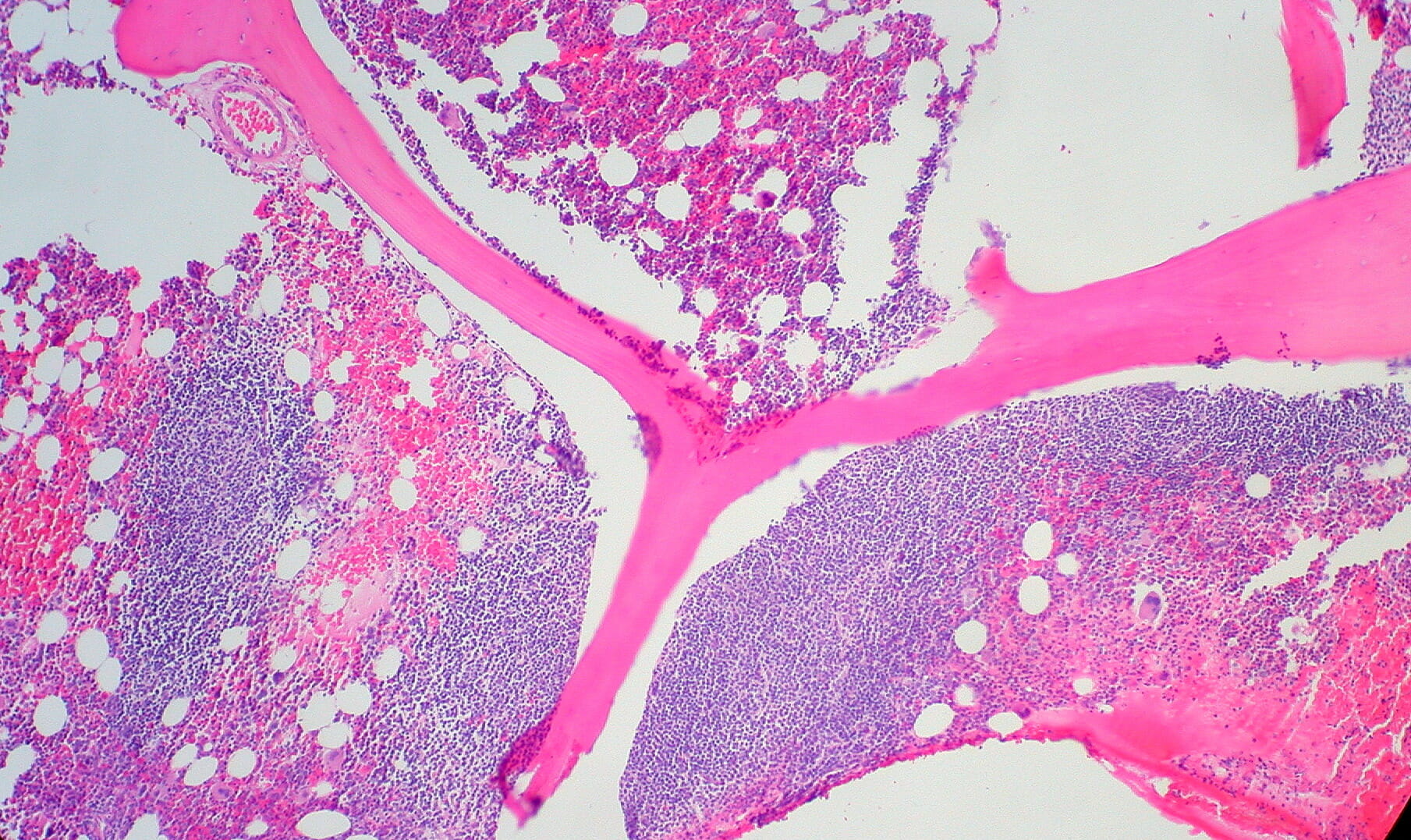
Bone marrow biopsy from a 34-year-old man with follicular lymphoma showing characteristic paratrabecular infiltrate
Image: “Follicular Lymphoma in Bone Marrow” by Ed Uthman. License: CC BY 2.0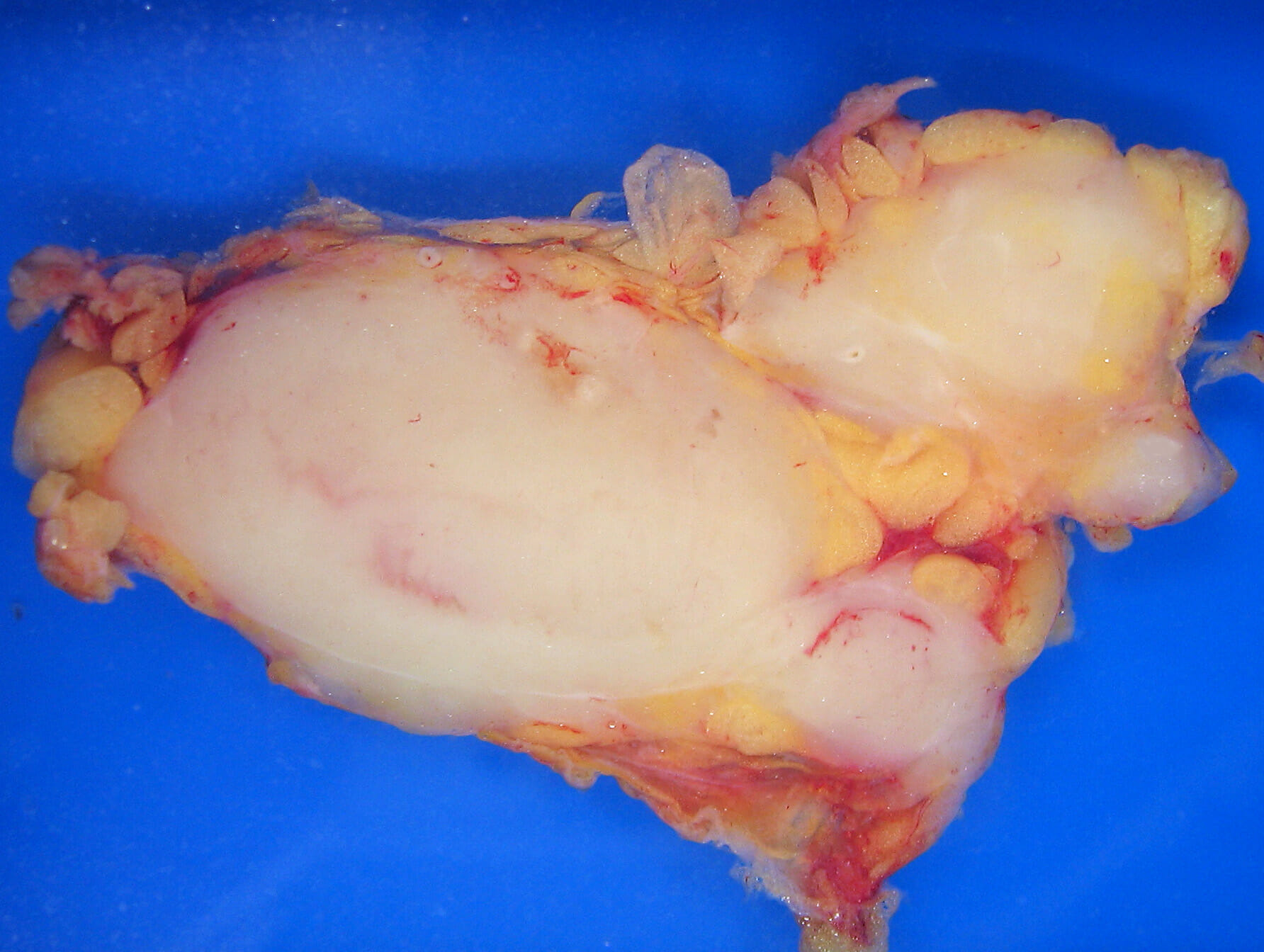
Gross pathology of follicular lymphoma in a lymph node
Image: “Lymphoma_macro” by Emmanuelm. License: CC BY 3.0| Stage I | Involvement of a single lymph Lymph The interstitial fluid that is in the lymphatic system. Secondary Lymphatic Organs node group or single extralymphatic organ |
|---|---|
| Stage II | Involvement of ≥ 2 lymph Lymph The interstitial fluid that is in the lymphatic system. Secondary Lymphatic Organs node groups on the same side of the diaphragm Diaphragm The diaphragm is a large, dome-shaped muscle that separates the thoracic cavity from the abdominal cavity. The diaphragm consists of muscle fibers and a large central tendon, which is divided into right and left parts. As the primary muscle of inspiration, the diaphragm contributes 75% of the total inspiratory muscle force. Diaphragm: Anatomy |
| Stage III | Involvement of lymph nodes Lymph Nodes They are oval or bean shaped bodies (1 – 30 mm in diameter) located along the lymphatic system. Lymphatic Drainage System: Anatomy, spleen Spleen The spleen is the largest lymphoid organ in the body, located in the LUQ of the abdomen, superior to the left kidney and posterior to the stomach at the level of the 9th-11th ribs just below the diaphragm. The spleen is highly vascular and acts as an important blood filter, cleansing the blood of pathogens and damaged erythrocytes. Spleen: Anatomy or both, on both sides of the diaphragm Diaphragm The diaphragm is a large, dome-shaped muscle that separates the thoracic cavity from the abdominal cavity. The diaphragm consists of muscle fibers and a large central tendon, which is divided into right and left parts. As the primary muscle of inspiration, the diaphragm contributes 75% of the total inspiratory muscle force. Diaphragm: Anatomy |
| Stage IV | Diffuse or disseminated involvement of ≥ 1 extralymphatic organs ( liver Liver The liver is the largest gland in the human body. The liver is found in the superior right quadrant of the abdomen and weighs approximately 1.5 kilograms. Its main functions are detoxification, metabolism, nutrient storage (e.g., iron and vitamins), synthesis of coagulation factors, formation of bile, filtration, and storage of blood. Liver: Anatomy, bone marrow Bone marrow The soft tissue filling the cavities of bones. Bone marrow exists in two types, yellow and red. Yellow marrow is found in the large cavities of large bones and consists mostly of fat cells and a few primitive blood cells. Red marrow is a hematopoietic tissue and is the site of production of erythrocytes and granular leukocytes. Bone marrow is made up of a framework of connective tissue containing branching fibers with the frame being filled with marrow cells. Bone Marrow: Composition and Hematopoiesis, lung) with or without lymph Lymph The interstitial fluid that is in the lymphatic system. Secondary Lymphatic Organs node involvement |
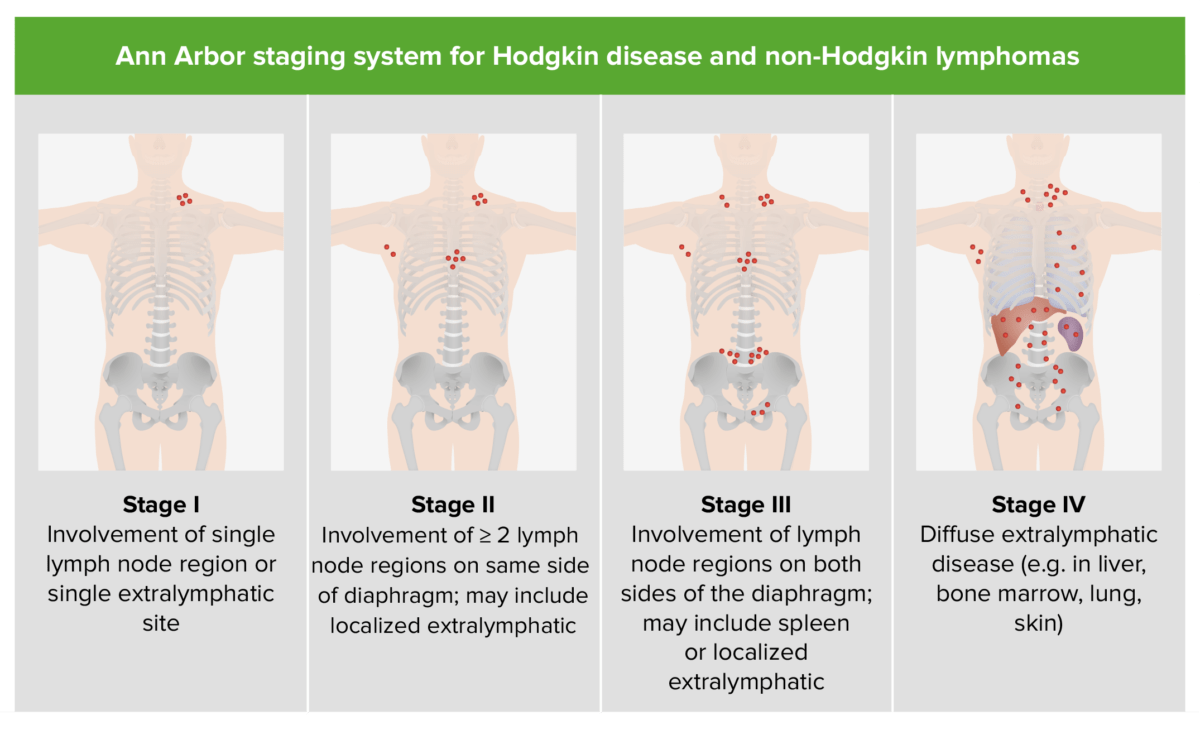
Staging of NHL (same as that for Hodgkin disease)
Image by Lecturio.Treatment is based on many factors, including histologic subtype, stage, and comorbidities Comorbidities The presence of co-existing or additional diseases with reference to an initial diagnosis or with reference to the index condition that is the subject of study. Comorbidity may affect the ability of affected individuals to function and also their survival; it may be used as a prognostic indicator for length of hospital stay, cost factors, and outcome or survival. St. Louis Encephalitis Virus. CD19 is highly expressed in nearly all B-cell malignancies, making it an attractive receptor Receptor Receptors are proteins located either on the surface of or within a cell that can bind to signaling molecules known as ligands (e.g., hormones) and cause some type of response within the cell. Receptors for novel targeted therapies.
High-grade NHLs are aggressive but have a better prognosis, whereas low-grade NHLs progress slowly but are difficult to cure.
International Prognostic Index (IPI) factors are associated with a worse prognosis:
Overall 5-year survival for NHLs as a group:
| Origin | Type | Risk factors and genetics Genetics Genetics is the study of genes and their functions and behaviors. Basic Terms of Genetics | Epidemiology | Pathology and clinical features |
|---|---|---|---|---|
| B cell (85%–90%) | DLBCL | Arises sporadically or from the transformation Transformation Change brought about to an organism’s genetic composition by unidirectional transfer (transfection; transduction, genetic; conjugation, genetic, etc.) and incorporation of foreign DNA into prokaryotic or eukaryotic cells by recombination of part or all of that DNA into the cell’s genome. Bacteriology of low-grade lymphoma Lymphoma A general term for various neoplastic diseases of the lymphoid tissue. Imaging of the Mediastinum (e.g., follicular lymphoma Lymphoma A general term for various neoplastic diseases of the lymphoid tissue. Imaging of the Mediastinum) |
|
|
| Follicular lymphoma Lymphoma A general term for various neoplastic diseases of the lymphoid tissue. Imaging of the Mediastinum | t(14;18) → overexpression of BCL2 ( gene Gene A category of nucleic acid sequences that function as units of heredity and which code for the basic instructions for the development, reproduction, and maintenance of organisms. Basic Terms of Genetics that regulates apoptosis Apoptosis A regulated cell death mechanism characterized by distinctive morphologic changes in the nucleus and cytoplasm, including the endonucleolytic cleavage of genomic DNA, at regularly spaced, internucleosomal sites, I.e., DNA fragmentation. It is genetically-programmed and serves as a balance to mitosis in regulating the size of animal tissues and in mediating pathologic processes associated with tumor growth. Ischemic Cell Damage) |
|
|
|
| Burkitt lymphoma Lymphoma A general term for various neoplastic diseases of the lymphoid tissue. Imaging of the Mediastinum |
|
|
|
|
| Mantle cell lymphoma Lymphoma A general term for various neoplastic diseases of the lymphoid tissue. Imaging of the Mediastinum | t(11;14) → overexpression of cyclin D1 |
|
|
|
| MZL |
|
|
|
|
| Lymphoplasmacytic lymphoma Lymphoma A general term for various neoplastic diseases of the lymphoid tissue. Imaging of the Mediastinum (Waldenström macroglobulinemia) | MYD88 gene mutation Gene Mutation Myotonic Dystrophies in most cases |
|
|
|
| T cell (10%–15%) | Adult T-cell lymphoma Lymphoma A general term for various neoplastic diseases of the lymphoid tissue. Imaging of the Mediastinum | Associated with retrovirus HTLV-1 |
|
|
| Mycosis Mycosis Fungi belong to the eukaryote domain and, like plants, have cell walls and vacuoles, exhibit cytoplasmic streaming, and are immobile. Mycosis is an infection caused by fungi. Mycology fungoides (cutaneous T-cell lymphoma Lymphoma A general term for various neoplastic diseases of the lymphoid tissue. Imaging of the Mediastinum) |
|
|
|